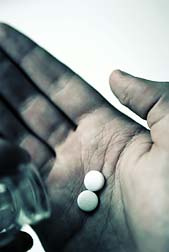 SJS is not discerning: many drugs, from over-the-counter (OTC) Ibuprofen to prescription can cause this serious disorder. It can often start with flu-like symptoms, which makes this illness even more insidious--the user will often continue taking the medication that is causing SJS symptoms. As well, if an OTC drug is the cause, chances are that person will not seek medical help until it is too late. About 20 percent of people diagnosed with SJS will die.
SJS is not discerning: many drugs, from over-the-counter (OTC) Ibuprofen to prescription can cause this serious disorder. It can often start with flu-like symptoms, which makes this illness even more insidious--the user will often continue taking the medication that is causing SJS symptoms. As well, if an OTC drug is the cause, chances are that person will not seek medical help until it is too late. About 20 percent of people diagnosed with SJS will die.Recovery can take a lifetime. Once SJS is determined to be caused by a medication, victims are warned to avoid that medication and all others related to it that may cause a similar reaction, because recurrences of Stevens-Johnson syndrome can be fatal. Some people have reported, even years after recovery, that they are terrified even to take Tylenol. Obviously the chances of a recurrence can pose a huge risk, and the future for SJS sufferers can be bleak. (Many SJS victims wear bracelets for the rest of their lives, warning not to give any medications—but given a particular circumstance such as a car accident or serious infection, that warning might be almost impossible to heed.)
What is SJS?
SJS is an immune-complex–mediated hypersensitivity disorder that is caused by a reaction to a variety of drugs, or by underlying viral infections and malignancies. Cell death results, which causes the first layer of skin to separate from the underlying layer (the dermis from the epidermis) and treatment is similar to burn victims. SJS was first described in 1922 and it is now generally regarded as SJS/TEN (toxic epidermal necrolysis). SJS typically involves the skin and the mucous membranes. During the course of the illness, it may develop to oral, nasal, eye, vaginal, urethral, GI, and lower respiratory tract mucous membranes. GI and respiratory involvement may progress to necrosis.
Missed diagnosis is common.
SJS Lawsuits in Store
READ MORE SJS LEGAL NEWS
Drug makers are aware that SJS and TEN pose serious risks associated with their drugs and drug companies have a responsibility to protect their drug users from adverse reactions. Although every allergic reaction cannot be prevented in all patients, the manufacturer owes it to the consumer, their doctors and even pharmacists to provide adequate knowledge and when necessary, warnings of serious side effects such as SJS and TEN. Drug companies must be held responsible for damages to the patient and their families. SJS lawsuits for wrongful death or negligence are mounting.Sharon West from Lake Tahoe has filed a suit after she took Lamictal (a prescription medication for bipolar disorder) and was diagnosed with SJS. Kevin's wife almost died after taking Dilantin—they are trying to find an attorney in Canada. And Lisa Oake's sister languished in hospital for months and put into a coma after taking Motrin.
How many people will suffer before these drug companies realize that SJS is not as rare as they think?




